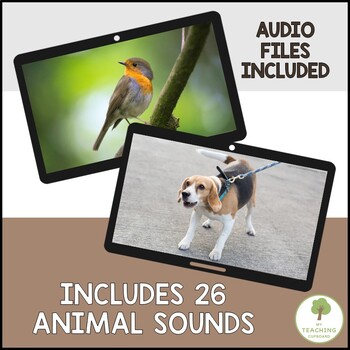Guess the Animal Sound Listening Activity - Auditory Discrimination PowerPoint
Description
Guess the Animal Sound is a fun PowerPoint game designed to teach auditory discrimination and basic phonemic awareness skills. This auditory processing listening activity will prepare students for hearing sounds (phonemes) in words. It can also be used in Science when you are learning about animals.
This fun PowerPoint game moves students through 3 levels of sound discrimination
- Identifying 26 single animal sounds
- Identifying and sequencing 2 familiar animal sounds in a sequence
- Identifying and sequencing 3 familiar animal sounds in a sequence
This is a quick and easy no-prep game to develop auditory memory and sequential processing skills. It will teach your students how to identify, recall and discuss the order of sounds.
It is a great morning meeting activity and can also be used in your Science Living Things Unit to deepen students’ understanding of animals and the sounds they make.
Best of all – this activity promotes active listening and teaches students to listen attentively.
I love it when I can use a resource multiple times throughout the year!
THIS ANIMAL SOUND DISCRIMINATION POWERPOINT CONTAINS:
- A 104 slides
- 26 different animal sounds
- 10 slides for students to identify and recall 2 animal sounds in a sequence
- 10 slides for students to identify and recall 3 animal sounds in a sequence
- Instructional slides guiding students through the process of identifying, recalling and sequencing familiar animal sounds.
CHECK OUT THE PREVIEW TO SEE SLIDE SAMPLES
For best results, play the PowerPoint in Presentation mode.
It contains audio files so you will need speakers.
Getting students to pay attention and actively listen is a game changer in any early childhood classroom. Sound discrimination activities like this one can help. When your students participate in sound discrimination activities, they learn about sounds AND the art of listening.
Using listening games like this resource is the first step in sound discrimination and sets the foundation for phonemic awareness. It’s also a great way to help your children become attentive listeners and what teacher doesn't need that
Students become better at recognising and analysing the sounds they hear through consistent practice in sound or auditory discrimination. If you want to help your children hear the sounds in words, you need to be teaching auditory discrimination.
Auditory or sound discrimination will help your students identify phonemes
within words.
Students first begin by recognising and distinguishing between familiar and unfamiliar sounds like the ones contained in this Powerpoint lesson. After mastering environmental and animal sound discrimination, children can progress to the next stage where they learn that spoken language consists of individual words.
While many educators dive straight into sound isolation, blending, and segmenting phonemes and introducing corresponding letters (graphemes) early on, don't overlook the importance of the initial stages of sound discrimination and attention-building.
CHECK OUT THE PREVIEW TO SEE HOW IT WORKS
Want to be notified about product updates and new listings?
CLICK HERE to follow my store on TpT
Stay in touch with My Teaching Cupboard
And HERE on my blog





